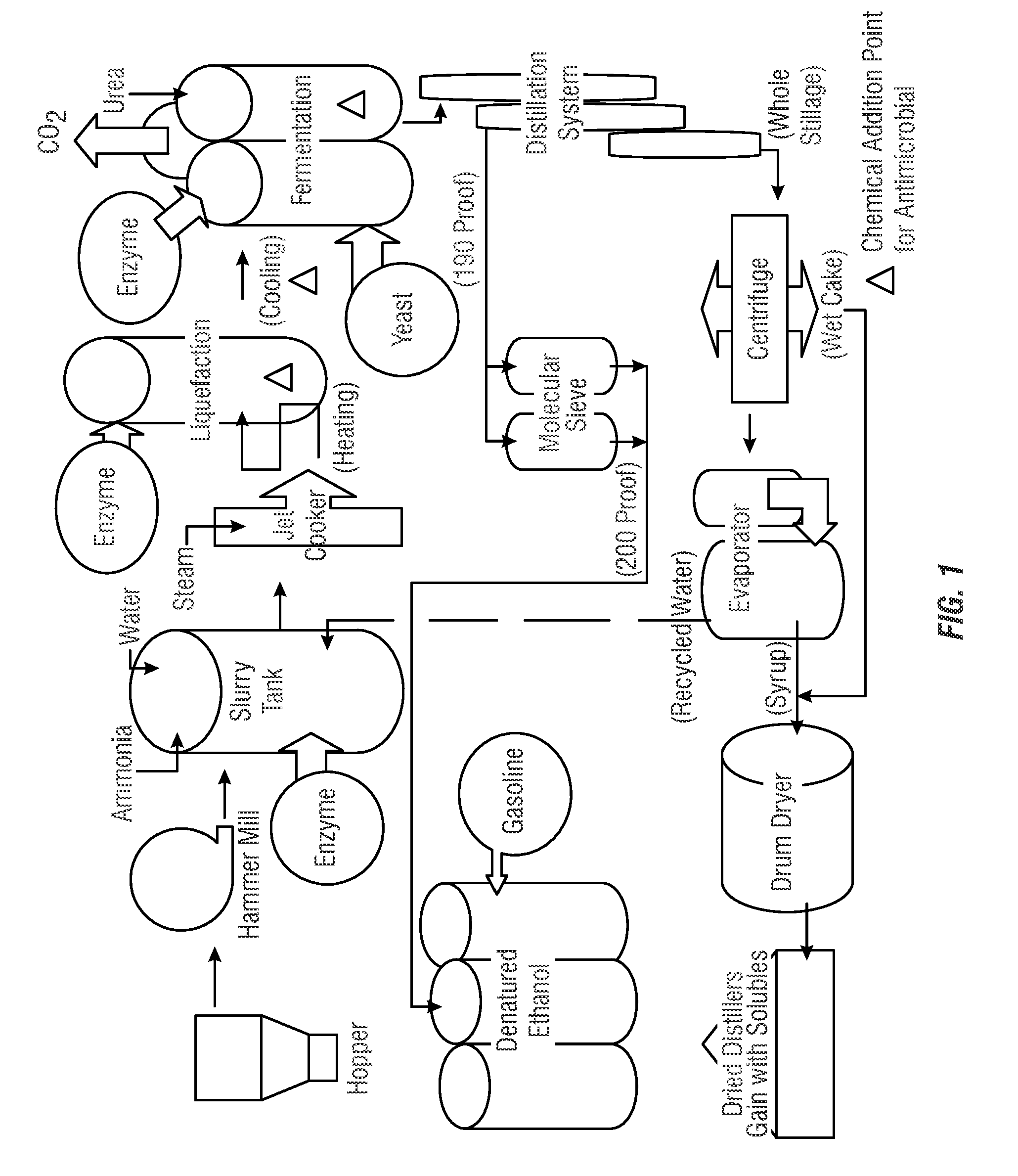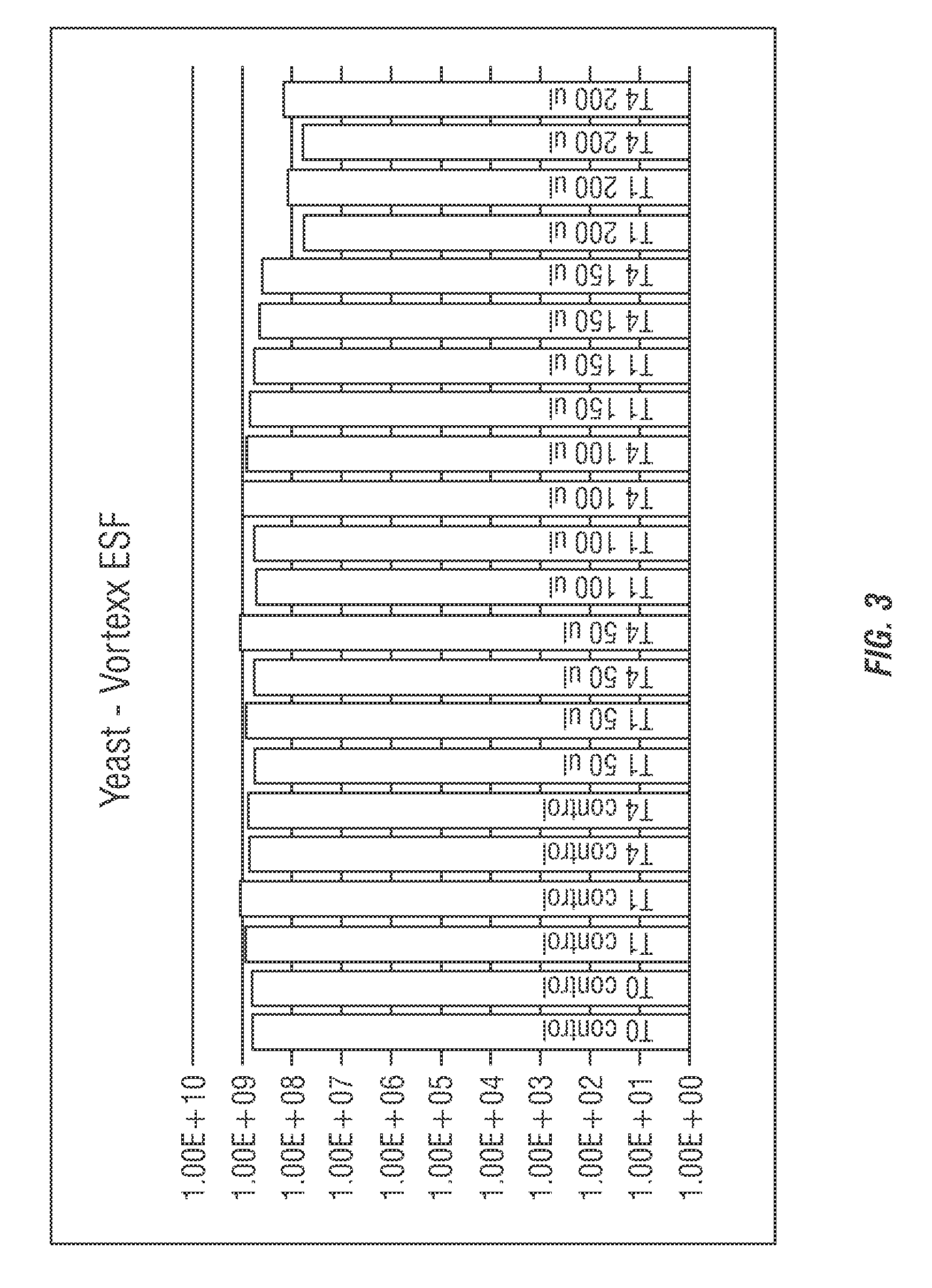Methods using peracids for controlling corn ethanol fermentation process infection and yield loss
a technology of corn ethanol fermentation and peracids, which is applied in the field of methods using peracids to control corn ethanol fermentation process infection and yield loss, can solve the problems of reducing production yield, reducing the efficiency of such ethanol fermentation, and reducing ethanol production, so as to improve ethanol yield, and reduce and/or eliminate microbial populations. the effect of yield loss
- Summary
- Abstract
- Description
- Claims
- Application Information
AI Technical Summary
Benefits of technology
Problems solved by technology
Method used
Image
Examples
example 1
[0134]Initial laboratory testing to confirm the performance of peracid compositions to suppress Lactobacillus species and Acetobacter species in the fermentation process was conducted. The biocide fermentation tests were conducted using Vortexx ESF (peracetic acid+octanoic acid) and Whisper V (quaternary ammonium compound) each commercially-available from Ecolab, Inc. The methods of the testing included:
[0135]Obtaining fermentation flasks containing 100 ml of fermentation mixture (10% of yeast+Lactobacillus brevis infection (ATCC Deposit No. 14869)+brown sugar juice 19° Brix).[0136]At Time zero (T=0)→>10% of yeast+Lactobacillus infection (ATCC Deposit No. 14869)+brown sugar juice 19° Brix.[0137]One hour after biocide addition in the flask (T=1)→>10% of yeast+Lactobacillus infection (ATCC Deposit No. 14869)+brown sugar juice 19° Brix+Vortexx ESF or Whisper V.[0138]Four hours after biocide addition in the flask (T=4)→>10% of yeast+Lactobacillus infection (ATCC Deposit No. 14869)+brown...
example 2
[0172]Additional testing was completed to analyze the efficacy of Vortexx ESF (peracetic acid+octanoic acid) (Ecolab, Inc.) and Octave (peroxyoctanoic acid) (Ecolab, Inc.) mixed peracid compositions for controlling bacterial contaminants in ethanol fermentation processes. As set forth in Example 1 there are inherent disadvantages to employing a peracid composition including peracetic acid / acetic acid and therefore there are superior peracid and mixed peracid compositions for use according to the methods of the invention that do not employ the peracetic acid.
[0173]The methods of the testing included:
[0174]Reagents
[0175]Solutions of Vortexx and Octave were provided by the Ecolab, Inc. The antibiotic Virginiamycin was purchased from SantaCruz Biotechnology. Ethanol Red yeast (Fermentis), and Lactobacillus fermentum were revived from 10% glycerol stocks maintained at 70° C. Yeast was grown at 30° C. under aerobic conditions in either liquid YPD medium or on YPD agar prior to use in prop...
PUM
| Property | Measurement | Unit |
|---|---|---|
| temperature | aaaaa | aaaaa |
| boiling points | aaaaa | aaaaa |
| solubility | aaaaa | aaaaa |
Abstract
Description
Claims
Application Information
 Login to View More
Login to View More - R&D
- Intellectual Property
- Life Sciences
- Materials
- Tech Scout
- Unparalleled Data Quality
- Higher Quality Content
- 60% Fewer Hallucinations
Browse by: Latest US Patents, China's latest patents, Technical Efficacy Thesaurus, Application Domain, Technology Topic, Popular Technical Reports.
© 2025 PatSnap. All rights reserved.Legal|Privacy policy|Modern Slavery Act Transparency Statement|Sitemap|About US| Contact US: help@patsnap.com



